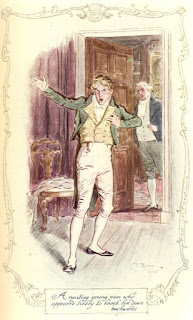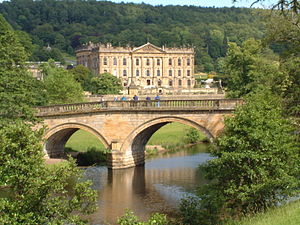Yes, we all like a play, especially when it is an adaptation of one of Jane Austen's novels. Jane Austen loved going to plays, especially when she could sit in a private box. "I talked to Henry at the play last night. We were in a private box -- Mr. Spencer's -- which made it much more pleasant..."
Of course, the production of a play is central to the story in Mansfield Park, where Jane Austen uses the appropriateness of the play and its production in the absence of Sir Thomas to demonstrate the moral differences between Fanny and, well, everyone else at Mansfield Park. Some of the story's most dramatic moments occur on the stage, as when Sir Thomas returns home after a long absence and finds his private study turned into a stage with an actor in full rant:
"He stepped to the door, rejoicing at that moment in having the means of immediate communication, and, opening it, found himself on the stage of a theatre, and opposed to a ranting young man, who appeared likely to knock him down backwards. At the very moment of Yates perceiving Sir Thomas, and giving perhaps the very best start he had ever given in the whole course of his rehearsals, Tom Bertram entered at the other end of the room; and never had he found greater difficulty in keeping his countenance. His father's looks of solemnity and amazement on this his first appearance on any stage, and the gradual metamorphosis of the impassioned Baron Wildenheim into the well-bred and easy Mr. Yates, making his bow and apology to Sir Thomas Bertram, was such an exhibition, such a piece of true acting, as he would not have lost upon any account. It would be the last--in all probability--the last scene on that stage; but he was sure there could not be a finer. The house would close with the greatest eclat." Mansfield Park chapter 19.
"A ranting young man..."
C. E. Brock
Given the importance of plays to Jane Austen and the role played by the theater in her stories, we are delighted that one of her novels is coming to the stage in our area. Students at Our Lady of Mercy High School will be presenting Jon Jory's adaptation of Pride and Prejudice on December 17, 18, and 19. Come and watch Elizabeth and Darcy misunderstand and then rediscover each other's character while Mr. Wickham does all he can to muddy the waters.
The performance should be an excellent opportunity to experience one of Jane Austen's best loved stories up close. With a talented cast and crew, Pride and Prejudice on Mercy's stage should be one of the best events of the season. Event details are below:
Event: Pride and Prejudice performed on stage by students at Our Lady of Mercy High School
When: December 17, 18, 19 7:30 pm
Where: Our Lady of Mercy Performing Arts Center, 1437 Blossom Road, Rochester NY
Tickets: At the door $8 general admission, $5 students/seniors
Info: http://www.mercyhs.com/about-mercy/news/1365-mercy-presents-pride-prejudice
The performance should be an excellent opportunity to experience one of Jane Austen's best loved stories up close. With a talented cast and crew, Pride and Prejudice on Mercy's stage should be one of the best events of the season. Event details are below:
Event: Pride and Prejudice performed on stage by students at Our Lady of Mercy High School
When: December 17, 18, 19 7:30 pm
Where: Our Lady of Mercy Performing Arts Center, 1437 Blossom Road, Rochester NY
Tickets: At the door $8 general admission, $5 students/seniors
Info: http://www.mercyhs.com/about-mercy/news/1365-mercy-presents-pride-prejudice













































